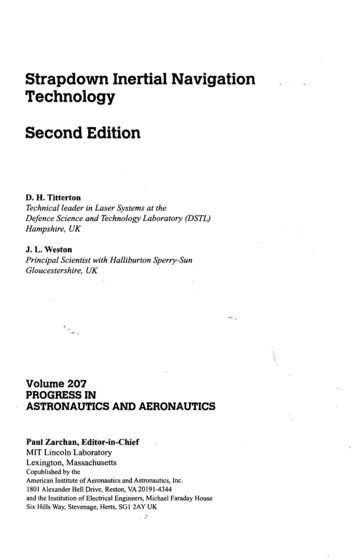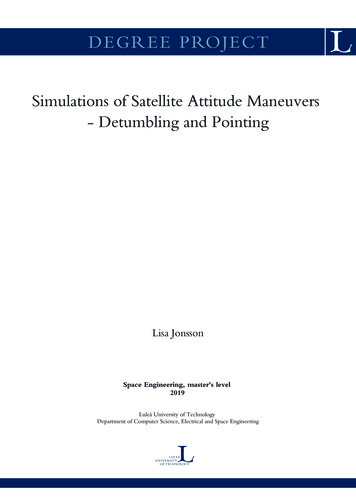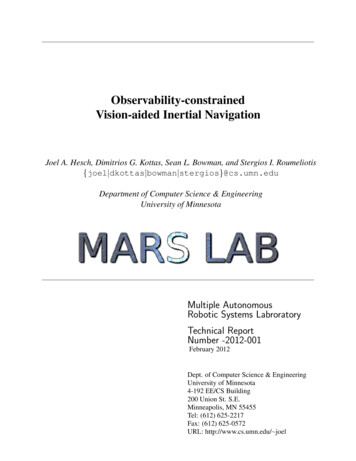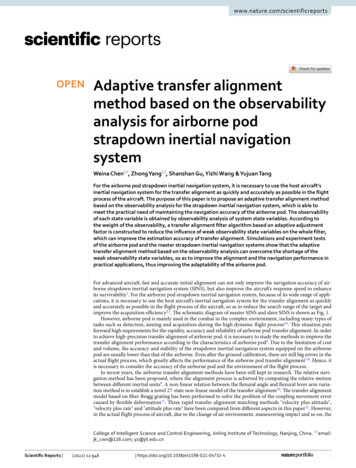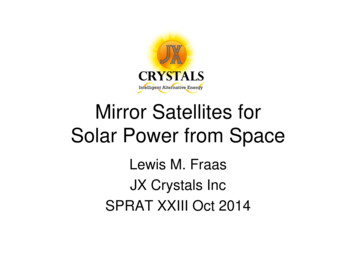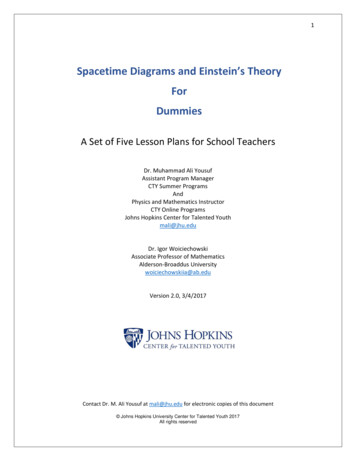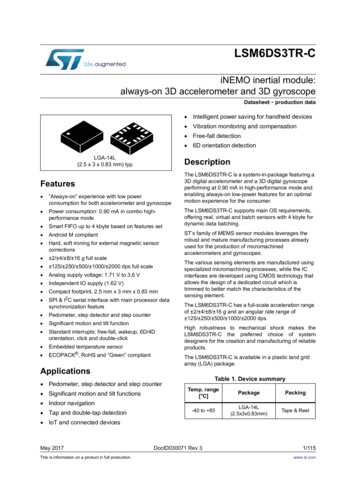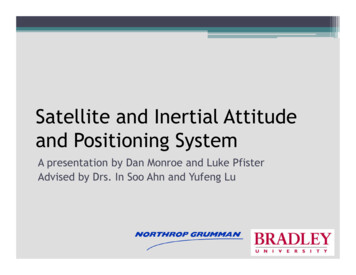
Transcription
Satellite and Inertial Attitudeand Positioning SystemA presentation by Dan Monroe and Luke PfisterAdvised by Drs. In Soo Ahn and Yufeng Lu
Outline Project Introduction Theoretical Background Inertial navigation GPS navigation Kalman filter Equipment List Progress Results Future Work Conclusion
Project Introduction Goal Fuse a GPS and an Inertial Measurement Unitusing a Kalman Filter Significance The final system will have the same functionalityand cost less than traditional Inertial NavigationSystems
Project Introduction Global Positioning System (GPS) Absolute position Accurate, but slow and prone to loss of signal
Project Introduction Inertial Measurement Unit (IMU) Provides acceleration, angular rates, and magneticreadings Can generate attitude and relative position usingstrapdown algorithm Fast, but noisy measurements.
Project Introduction MEMS IMU Advantages Low cost MEMS IMU Drawbacks Bias value Bias drift White noise
Project Introduction
Project Introduction
Strapdown Solution
Theoretical Background Inertial Navigation System (INS) Dead reckoning with inertial measurement unit(IMU) Strapdown navigation Closed loop controls and integrators
Theoretical Background Strapdown Solution
Theoretical Background Local tangent plane navigation
Theoretical Background GPS navigation Trilateration with satellite messages Timing ambiguity: need at least 4 satellites
Kalman Filter
Kalman Filter Optimal linear state estimator Estimates system states through noisymeasurements Need: system model and signal models
Kalman Filter System Model Position (3)Velocity (3)Acceleration Bias (3)Quaternion (Attitude) (4)Angular Rates Bias (3) Observables GPS ENU Position(3) GPS ENU Velocity(3)
Kalman Filter Signal Model First Order Model (Gauss Markov) Requires signal variance and autocorrelation timeconstant
Kalman Filter Extended Kalman filter Linearizes about an operating point Can be inaccurate for highly nonlinear systems
Kalman Filter Unscented Kalman filter Generates a finite number of sigma points whichhave the same mean and variance as the input Evaluates the nonlinear function only on thesigma points Robust to high nonlinearity
Kalman FilterD. Simon, Optimal State Estimation. Hoboken, NJ: John Wiley & Sons, 2006.
Progress
Equipment List Vector Nav VN-100 Three sets of MEMS sensors Magnetometers Gyroscopes Accelerometers uBlox EVK-5T LEA-5T GPS module Accurate up to 2 meters RMS
Experimental Results
Experimental Results Experimental Setup
Experimental Results Strapdown Solution and Linear Kalman Filter
Experimental Results Unscented Kalman filter
Experimental Results Error between GPS and UKF INS solutionPositionVelocityGPSInterpolationMeanStd DevMeanVelocityStd Dev ObservablesNot0.20830.82220.14420.1411 WithNot0.20150.49308.20154.2729 WithoutInterp.0.00500.00290.11330.0501 WithInterp.0.12560.06718.12684.2731 Without
Experimental Results State Covariance Matrices: Interpolated and Not
Experimental Results Bias Estimation Results
Experimental Results GPS Outages
Future Work Error Models Find better Gauss-Markov parameters2nd Order ARMA sensor modelModel lever-arm effectTightly coupled system Timing Synchronization Attitude Initialization Real-Time Hardware Implementation
Conclusions Developed system model (strapdown) Developed signal model Implemented linear and Unscented Kalmanfilter
References A. Waegli and J. Skaloud, “Optimization of two gps/mems-imu integration strategies withapplication to sports, GPS Solutions”, Available: http://dx.doi.org/10.1007/s10291-009-0124-5. D.H. Titterton and J.L. Weston, “Strapdown Inertial Navigation Technology”, 2nd Edition, TheInstitution of Electrical Engineers, 2004. C. Hide and T. Moore, “GPS and Low Cost INS Integration for Positioning in the UrbanEnvironment”, In Proceedings of the Institute of Navigation GNSS 2005, Long Beach, CA,September 2005. J.L. Crassidis, ”Sigma-point Kalman filtering for integrated GPS and inertial navigation,” IEEETransactions on Aerospace and Electronic Systems, vol. 42, pp 750-755, Dec. 2006. D. Simon, “Optimal State Estimation,” Hoboken, NJ: John Wiley & Sons, 2006. R. Brown and P. Hwang, “Introduction to Random Signals and Applied Kalman Filtering”, NewYork City, NY: John Wiley & Sons, 1992.
Kalman FilterForm initial estimates ofstates and error covariancesUpdate Kalman GainGenerate Sigma PointsTake measurement andcreate refined state estimatePredict system states anderror covariancesUse refined measurements toupdate error covariance
Kalman Filter
Sensor Modeling Gauss-Markov Process Gaussian Distribution Markov Process Autocorrelation: PSD:
Sensor Modeling Modeling Process Remove meanFocus on a ‘quiet’ portion of dataSeparate into small segment of dataCalculate the variance of each segmentUse the mean variance and PSD to find timeconstant
Sensor Modeling
Sensor Modeling
Sensor Modeling
Sensor Modeling
Sensor Modeling
Sensor Modeling
State Equations
Interfacing Issues
Interfacing Issues
D.H. Tittertonand J.L. Weston, "Strapdown Inertial Navigation Technology", 2nd Edition, The Institution of Electrical Engineers, 2004. C. Hide and T. Moore, "GPS and Low Cost INS Integration for Positioning in the Urban
